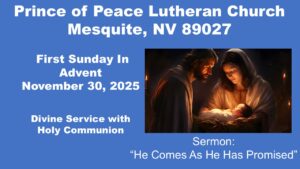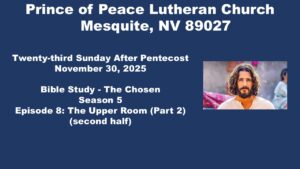The Time of Christmas
Advent
Begins the fourth Sunday before December 25th, or the Sunday closest to St. Andrew (November 30th), and ends with midday prayer on December 24.
The Savior’s birth is second in importance only to His resurrection on Resurrection Sunday. During the Time of Christmas, Christians reflect on God’s gracious gift of Himself.
Advent Practices and Traditions:
– The color for Advent is blue, which symbolizes anticipation and hope in our coming King. Violet can also be used during Advent as a symbol of our repentance in preparation for our coming King.
– We do not sing the Gloria in Excelsis in the Divine Service during Advent. This is the angels’ song at Christmas, so during Advent, we pass over this traditional Hymn of Praise in silent anticipation.
-It has become common to use an Advent wreath to mark the season. This wreath has four candles – one for each week in Advent. As these candles are lit each week, our anticipation mounts as we look forward to Jesus’ coming.
The Time of Christmas
Christmas and its season
Begins with evening prayer on Christmas Eve and ends with midday prayer on January 5th.
Christmas tells the story of Jesus as the long-awaited King who has finally come to save us. Jesus, God’s Son, the King of heaven and earth, is born in Bethlehem-the Son of God is a baby laying in a manger.
The evening services of Christmas Eve mark the beginning of the Church’s celebration of the Nativity of Our Lord. The season continues after December 25th over a period traditionally known as the twelve days of Christmas. This season includes a number of festivals:
– December 26th: St. Stephen, the first Martyr.
– December 27th: St John, apostle and evangelist.
– December 28th: the Holy Innocents, the death of the babies in Bethlehem.
Christmas practices and traditions:
– We sing the Gloria in Excelsis and join the angels at Christmas in their Hymn of Praise: “Glory be to God on high, and on earth, peace, goodwill toward men.”
– The color for Christmas and its season is white, symbolizing the divinity, eternity, purity, light, and joy of Jesus Christ.
– Many Christians celebrate with special services during the Christmas season
— A special Divine Service late on Christmas Eve reminds us how the angels announced the birth of Jesus to shepherds who were “keeping watch over their flocks by night.”
— On Christmas Day we celebrate the Word of God made flesh and receive Him in the Means of Grace (Holy Scripture and the Holy Sacraments of Baptism and Communion).
— January 1st, eight days after His birth, we gather in worship to begin the year in His name. Jesus, which means “the Lord saves,” for He has come to save His people from their sins.
The Time of Christmas
Epiphany and its season
Begins with evening prayer on January 5th and the Tuesday before Ash Wednesday.
Epiphany is one of the oldest seasons in the Christian Church Year, second only to the Easter Season. This season of lights emphasizes Jesus’ manifestation (or epiphany, from the Greek epiphaneia) as God and man. The earliest Christians called the feast ofr the Epiphany the Theophany (“revelation of God”). When the Gentile Magi come to worship Jesus, they show that everyone now has access to God. Now all people, Jew and Gentile, can come to God’s temple and worship, because Jesus is the new temple: God in the flesh. The Epiphany of our LORD (January 6th) marks the celebration of the visit of the Magi.


